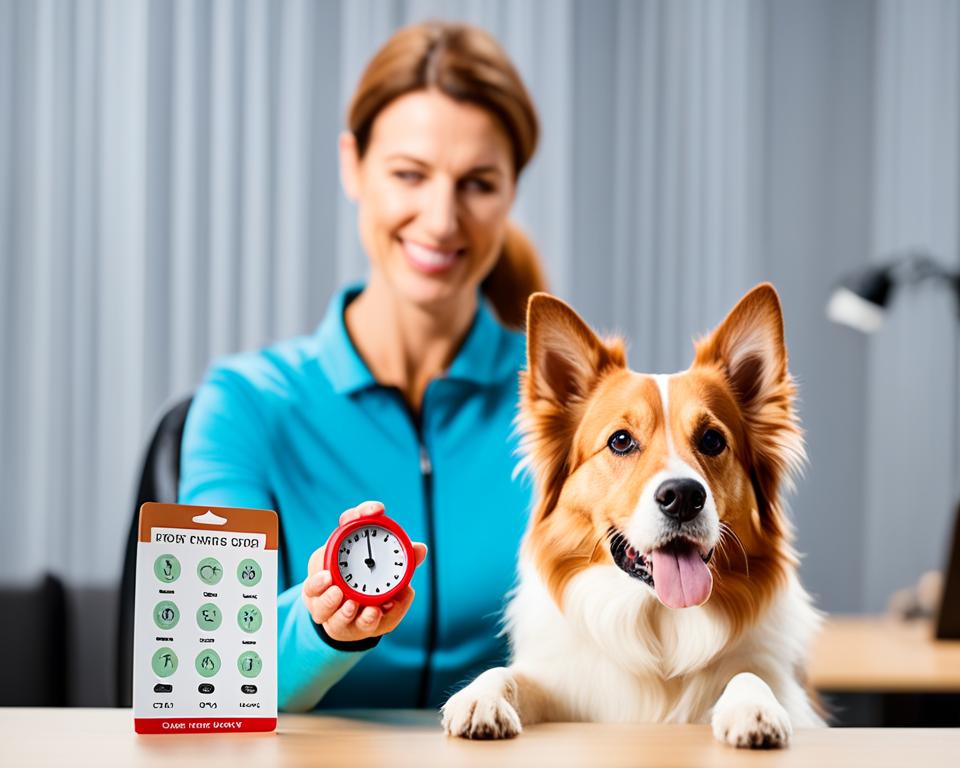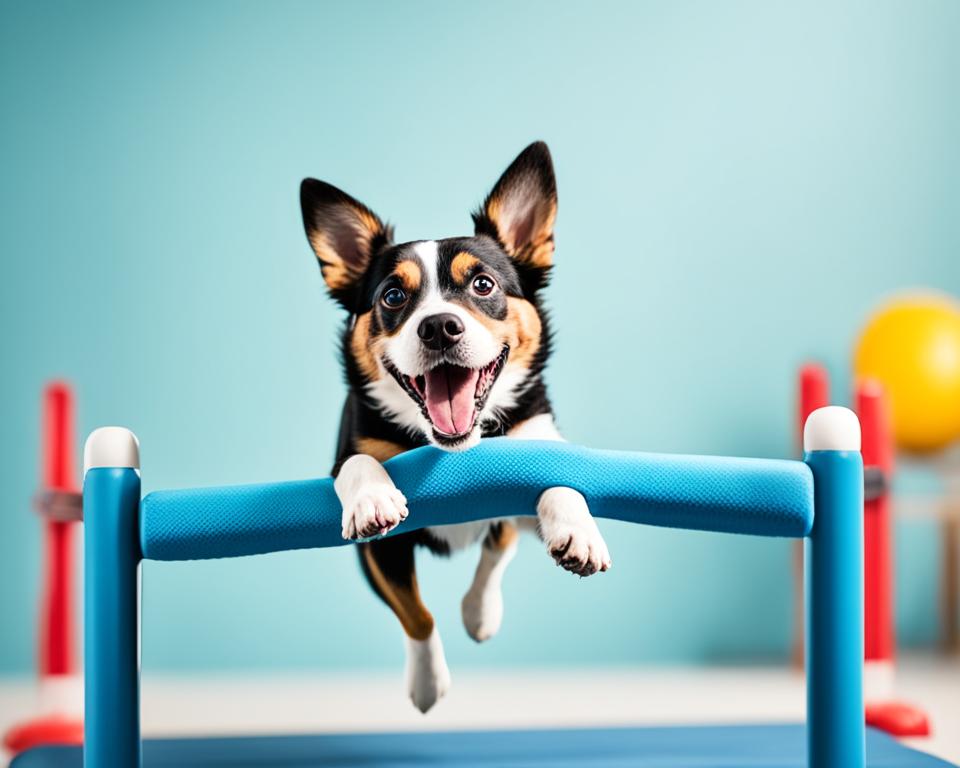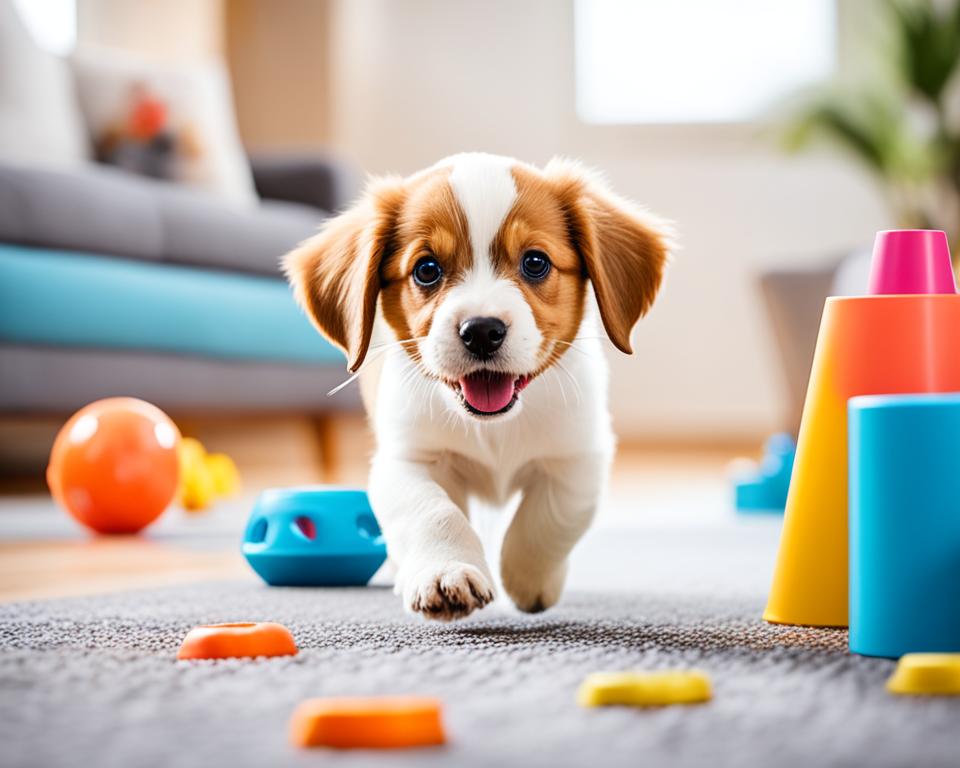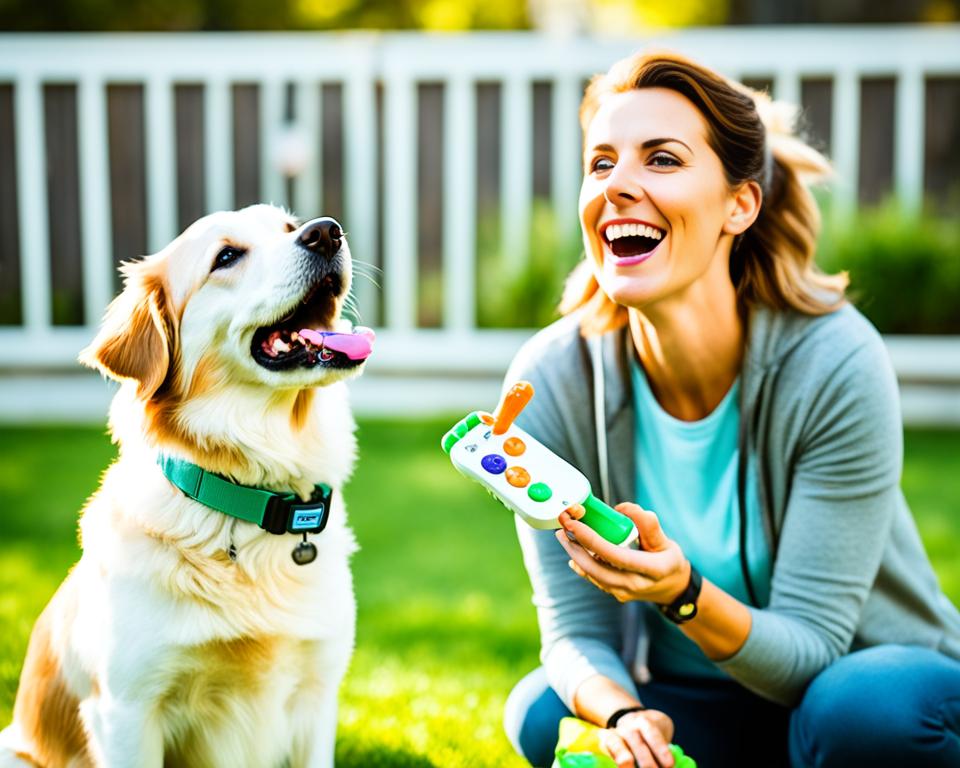Training pets is key for their happiness and our peace of mind. As a pet owner, I’ve found that using positive reinforcement works best. Vets say it’s the top way to teach pets new things.
Short training sessions are best. The American Kennel Club says to keep them under five minutes. This keeps pets from getting tired or upset. Doing these short sessions often is better than one long one.
Being consistent in training is very important. Everyone in the house must agree on commands and rules. This makes pets learn faster and remember what they’ve learned. I make sure to practice in different places to help my pet use their skills everywhere.
Understanding the Importance of Pet Training
Pet training is key to a happy life with pets. It makes sure pets and owners get along well. Training helps pets behave better and keeps everyone safe.
Building a Strong Bond with Your Pet
Training helps you connect with your pet. You learn about their personality and what they need. This is very important when they are young.
Creating a Well-Behaved Companion
Training helps fix bad behaviors like jumping or barking too much. It makes pets fit in better at home and out. Sadly, many pets end up in shelters because they weren’t trained.
Ensuring Safety for Your Pet and Others
Training keeps pets and others safe. It teaches pets to listen and behave. This is very important in new places or situations.
“Training supports pets in becoming happy and well-adjusted members of the family and society.”
It’s never too late to start training your pet. Whether they are young or old, training makes your bond stronger and happier.
Positive Reinforcement: The Key to Successful Pet Training
Positive reinforcement is a big help in pet training. It rewards good behavior, making pets more likely to do it again. Let’s look at why it works and how to use it.
Timing is very important in positive reinforcement. Rewards should come right after the good behavior. This helps pets understand what they did right. Using commands like “sit,” “stay,” and “down” helps a lot.
Being consistent is also key. If everyone uses the same cues, pets won’t get confused. I’ve taught my dog to sit before going outside or eating this way.
For harder behaviors, I use shaping techniques. This means slowly teaching the skill. You can use treats, praise, petting, or toys as rewards. Small, soft treats are great for quick rewards during training.
Positive reinforcement strengthens behavior and builds trusting relationships between pet parents and their animal companions.
Clicker training is another good method. The clicker marks the good behavior. I make sure training is short, fun, and ends well.
| Training Aspect | Positive Reinforcement Approach |
|---|---|
| Timing | Reward within seconds of desired behavior |
| Communication | Use consistent verbal cues |
| Rewards | Vary between treats, praise, and toys |
| Session Length | Keep short and enjoyable |
| Goal | Have fun while strengthening behaviors |
Every pet is different. What works for one might not work for another. Be patient, consistent, and keep training positive and fun.
Choosing the Right Rewards for Your Pet
Finding the best rewards is key to training pets. Positive reinforcement with the right rewards works great. Let’s look at some good options to motivate your pet during training.
Food-Based Rewards
Treats are a top choice for many. Use small, soft treats that your pet can eat fast. They should be about the size of an eraser head. For picky eaters or tough tasks, use stronger-smelling, tastier treats to boost motivation.
Toy and Play Rewards
Some pets like play rewards better. A quick game of tug-of-war or fetch can really motivate them. Adding favorite toys to training makes it fun for you and your pet.
Affection and Praise as Rewards
A good scratch behind the ears or a “Good boy!” can go a long way. Many pets love affection and praise. These rewards are great for encouraging good behavior all day.
| Reward Type | Examples | Best Used For |
|---|---|---|
| Food | Small treats, kibble | Most training situations |
| Toys | Squeaky toys, balls | High-energy pets |
| Affection | Petting, verbal praise | Reinforcing good behavior |
Success in training comes from knowing what motivates your pet. Don’t hesitate to try different rewards to keep training fun and engaging.
Consistency: The Cornerstone of Effective Training

Consistency is key in pet obedience training. Using the same words and tone for commands helps my pet learn faster. It’s like speaking a language they get.
It’s important to have everyone in the house use the same training rules. This avoids confusion and strengthens good habits. When we’re all on the same page, my pet learns new habits better.
Here are some tips for keeping training consistent:
- Keep training sessions short, around 5-10 minutes
- Use consistent verbal commands and hand signals
- Reward good behavior right away and always
- Correct bad behavior quickly by focusing on something else
- Practice in different places to make behaviors last everywhere
Patience is important. Consistent training takes time, but it’s worth it. My pet is now more obedient and confident, which has made our bond stronger. Remember, a little bit of daily training is better than a lot once a week.
“Consistency is the key to unlocking your pet’s full potential in obedience and behavior.”
Following these principles has really helped my pet’s behavior. It’s surprising how a bit of consistency can make a big difference in training and changing behavior.
Short and Sweet: The Ideal Length for Training Sessions
Training pets should be short and sweet. Short, frequent sessions are great for puppies and adult dogs. Let’s look at some basics for training puppies.
Keeping Sessions Under 5 Minutes
Dogs can focus on training for 5-15 minutes. Puppies need even shorter sessions. Start with 30-60 seconds and increase as they learn.
Repeating Sessions Throughout the Day
Instead of one long session, spread training out during the day. This helps your pet remember what they learned. Use commands before daily activities, like sitting before meals.
This makes training part of everyday life.
Adapting to Your Pet’s Attention Span
Every pet is different. Some focus for a minute, others longer. Always end sessions before they lose interest.
This keeps training positive and makes them want more.
| Pet Age | Recommended Session Length | Daily Frequency |
|---|---|---|
| 8-16 weeks | 1-2 minutes | 3-4 times |
| 4-6 months | 2-3 minutes | 2-3 times |
| 6+ months | 3-5 minutes | 1-2 times |
Consistency is key in pet training. Short, regular sessions work better than long, infrequent ones. Keep training short and fun, and you’ll see progress fast!
Training Tips for Pets: Essential Techniques and Strategies
I’ve found some amazing training tips for pets that can make a big difference. Consistency is key when house-training pets or teaching basic obedience. I start with short sessions, under 10 minutes for puppies. This keeps their attention and makes learning fun.
One of my favorite leash training tips is to begin indoors in a quiet area. As your pet gets comfortable, slowly move to more distracting places. Remember, patience is key when training pets of any age.

Using hand signals with verbal commands works great. Many pets respond better to visual cues. Here’s a quick guide to some basic commands and their corresponding hand signals:
| Command | Verbal Cue | Hand Signal |
|---|---|---|
| Sit | “Sit” | Palm up, moving from nose to above head |
| Stay | “Stay” | Open palm facing pet |
| Come | “Come” | Pat your thigh or clap hands |
| Down | “Down” | Point to the ground |
Incorporating training into daily routines has changed the game for me. I ask for a simple command before meals or walks. This reinforces good behavior all day. It makes training a natural part of our lives, not just a separate activity.
“Praise improvements, no matter how small. It keeps both you and your pet motivated.”
By following these training tips for pets, you’ll be on your way to a well-behaved companion. Remember, every pet learns at their own pace. Stay patient and enjoy the journey!
Breaking Down Complex Behaviors into Manageable Steps
Behavior modification strategies are vital for complex pet behaviors. As a seasoned trainer, I’ve learned that breaking tasks into smaller steps is key. This method is the core of successful puppy training basics.
Let’s see how this method works for common training issues:
| Complex Behavior | Manageable Steps |
|---|---|
| Heel Command | 1. Teach attention focus 2. Reward for walking beside you 3. Gradually increase duration 4. Add distractions |
| Stay Command | 1. Start with short distances 2. Increase duration gradually 3. Add distractions 4. Practice in different locations |
| Agility Training | 1. Introduce equipment separately 2. Teach basic commands 3. Combine obstacles slowly 4. Increase speed and complexity |
Breaking complex behaviors into smaller steps makes learning easier for pets. I always reward small steps first. This method lowers frustration for pets and owners, making training fun and successful.
Consistency is crucial in using these strategies. Short, regular training sessions work better than long, rare ones. With patience and effort, your pet will master complex behaviors quickly!
Making Training Fun and Engaging for Your Pet
Training your pet doesn’t have to be dull! I’ve learned that making training fun is crucial for success. By adding play, teaching tricks, and changing settings, you can keep your pet eager to learn.

Incorporating Play into Training
I enjoy blending short play times with training. This keeps my pet’s energy high and keeps them interested. For instance, after practicing “sit,” we play fetch before moving to “stay.” This makes training feel like fun, not work.
Teaching Tricks Alongside Obedience
Adding tricks to obedience training keeps things exciting. While teaching “down,” I also teach fun tricks like “roll over” or “high five.” This mix prevents boredom and boosts confidence. Plus, it’s fun to show off your pet’s new tricks to others!
Varying Training Environments
Training in different places has really helped my pet. We train in various rooms, the backyard, and even at the park. This helps my pet understand commands better and keeps them mentally sharp. It’s cool to see how well they do in new places!
| Training Element | Benefits | Examples |
|---|---|---|
| Play Integration | Maintains energy and interest | Fetch between commands |
| Trick Training | Prevents boredom, builds confidence | “Roll over,” “High five” |
| Environment Changes | Improves command generalization | Indoor, outdoor, public spaces |
Using positive reinforcement and making training fun has greatly improved my pet’s behavior and our relationship. The main thing is to keep it enjoyable, varied, and rewarding for both you and your pet!
The Power of Praise: Celebrating Small Victories
Celebrating small wins is key in training pets. When I began training my dog, I saw big changes from tiny steps. Experts say 95% of the time, positive reinforcement works best.
Here’s why praising your pet is important:
- Builds confidence
- Keeps your pet engaged
- Strengthens your bond
- Encourages repeat behaviors
Using high-value treats as rewards keeps my dog excited to learn. Short, positive sessions keep him focused. By praising every small win, my pet’s behavior has greatly improved.
“Patience, consistency, and celebrating successes with praise, pets, and treats are essential for effective trick training.”
Customized dog training changed everything for us. It fits my dog’s unique needs, improving obedience and communication. Positive reinforcement and tailored methods helped solve common issues.
Remember, 68% of households see better pet behavior with consistent training. So, keep celebrating those small wins. They lead to a well-behaved, happy pet!
Integrating Training into Your Daily Routine
Adding training tips for pets to daily life changes everything. It’s not about setting aside time. It’s about making every moment count. For instance, I make my dog sit before meals or walks. This makes training a part of our daily routine.
Being consistent makes house-training pets easier. I use commands like “leave it” indoors, starting with toys. Then, I use food or favorite toys on the floor. This helps my dog learn to control their impulses.
One trick I enjoy is practicing the “stay” command during different activities:
- While I’m eating
- When I’m brushing my teeth
- As I’m cooking dinner
This helps my dog get better at the command in various situations. I make it harder by increasing the time or taking away their mat. They learn fast!
Recall training is also a daily routine. I call my dog from other rooms and give them treats and attention. It’s a fun way to strengthen our bond and improve their obedience. Remember, being consistent is important. With regular practice, these tips become easy for pets, making them well-behaved and happy.
When to Seek Professional Help: Recognizing the Need for Expert Guidance
Pet obedience training can be tough, especially with complex behavior issues. If you’re having trouble with your pet’s behavior or feel overwhelmed, it’s time to get expert help. Professionals in pet behavior modification can offer custom solutions for your pet’s needs.
There are many experts to choose from. Certified Professional Dog Trainers (CPDTs) have lots of experience and pass tough tests. For big issues, Applied Animal Behaviorists or Veterinary Behaviorists might be a better choice. They have advanced degrees and can handle complex problems like aggression or severe anxiety.
When picking a professional, talk to more than one. This helps you compare methods and find the best one for you and your pet. Look for trainers who use positive methods and have good reviews. Remember, getting professional help can make a big difference in your pet’s training.

